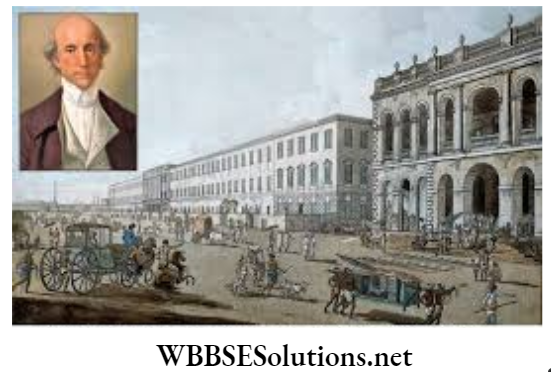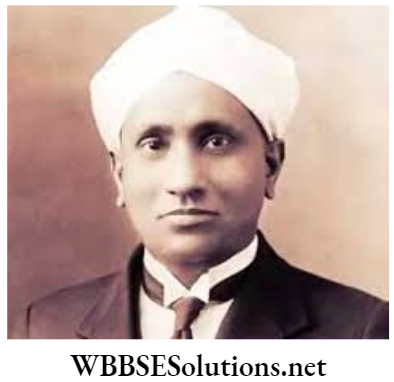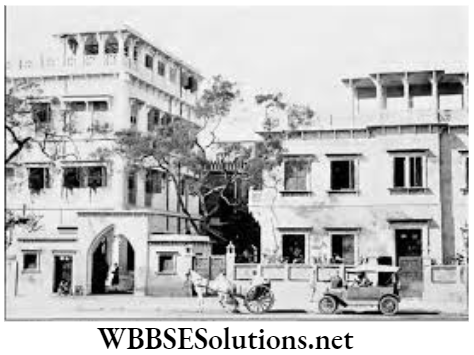Chapter 5 Alternative Ideas And Initiatives Characteristics And Observations Topic A Development Of Printing Press In Bengal Short Answer Type Questions
Question 1 When and where was the first printing press of the Portuguese started?
Answer:
The first printing press of the Portuguese started in Goa on April 30, 1556.
Question 2 In which year and by whom was Persian Press established?
Answer:
Persian Press was established by Matthew Lumsden in 1805.
Question 3 Who established the Sanskrit Press and when?
Answer:
Baboo Ram with the help of Colebrooke established the Sanskrit Press in 1807.
Read and Learn More WBBSE Class 10 History Short Answer Questions
Question 4 Who was Baboo Ram?
Answer:
Baboo Ram:
Baboo Ram was the teacher of Sanskrit language and literature at Fort William College. He established the Sanskrit Press in 1807.

Question 5 Who wrote ‘Kripa Sastrer Arthaved’ and in which language?
Answer:
Manuel da Assumpcao wrote ‘Kripa Sastrer Arthaved’. It was written in Bengali.
Question 6 Who published the ‘Bengal Gazette’ and when?
Answer:
Bengal Gazette:
James Augustus Hicky published the ‘Bengal Gazette’. It was published on January 29, 1780.

Question 7 Why was ‘Hicky’s Bengal Gazette’ important?
Answer:
Importance Of ‘Hicky’s Bengal Gazette’
‘Hicky’s Bengal Gazette’ was important for various reasons. It was the first major newspaper in India and it also spread patriotism among the people of the nation. Moreover, it was free and independent.
Question 8 Who established the Bengali Gazette Press and when?
Answer:
Ganga Kishore Bhattacharya established the Bengali Gazette Press in 1818.
Question 9 Who set up the Sanskrit Press and Depository? What was their objective?
Answer:
Iswar Chandra Vidyasagar and Madanmohan Tarkalankar set up Sanskrit Press and Depository. Their objective was to spread education among the masses by publishing their writing and opinion.
“WBBSE Class 10 history chapter 5 key observations”
Question 10 What role did the hawkers of Battala play in the Bengali press business?
Answer:
The hawkers of Battala play in the Bengali press business:
The battle of Calcutta played an important role in the business of the Bengali press. Hawkers were employed to dispatch books published from Battala to distant villages. The hawkers used to sell books in towns and far-off villages.
Sometimes, instead of taking cash for the books, they took old books in exchange. They sold these books in Calcutta in different printing presses. As the books of Battala were cheap, their market was good.
Question 11 Why did Rammohan Roy fight against Adam’s Press Regulations (1923)?
Answer:
Rammohan Roy fought against Adam’s Press Regulation (1923) because there was a clear distinction between the Anglo-Indian and Indian presses. Various restrictions were imposed on the Indian Press while there was no restriction on the Anglo-Indian press.
“Characteristics of initiatives in India short answers”
Question 12 In which year was Fort William College established and by whom? Which languages were taught there?
Answer:
Fort William College was established in 1800 by Lord Wellesley. Various languages like Parsee, Bengali and Hindusthani were taught there.
Question 13 What was the role of Panchanan Karmakar in the development of Bengali Press?
Answer:
The role of Panchanan Karmakar in the development of Bengali Press:
Panchanan Karmakar, a skillful goldsmith, designed and developed a set of letters for typing in Bengali. He is called ‘Father of Bengali Typewriting’. Serampore Mission Press used his designs to publish their Bengali books.
Question 14 Who was Charles Wilkins?
Answer:
Charles Wilkins:
Charles Wilkins, a British East India Company Official, set up a printing press at Chinsurah in Hooghly in 1778. He designed a Bengali script, a style of letters, for the first time with the purpose of printing. However, those letters were quite simple and of inferior quality.
Question 15 What is the importance of the introduction of linotype printing in Bengali?
Answer:
The importance of the introduction of linotype printing in Bengali:
Suresh Chandra Majumdar devised a set of letters known as ‘linotype’ which was a highly developed design of letters. It became one of the mainstay methods to set type. Nathaniel Brassey Halhed’s ‘A Grammar of the Bengal Language’ was printed using a linotype.
Question 16 What is the importance of Battala Prakashana in the history of Bengali Press?
Answer:
The importance of Battala Prakashana in the history of Bengali Press:
Battala Prakashana is situated in the Sovabazar and Chitpur areas of Calcutta. It is often considered as the earliest center of printing and publishing in Calcutta. It began the printing and publication industry in Bengal in the 19th century. Putih, Panchali, and Panjika (Calender) myths and legends were the main publications of Battala. Cheap editions of religious books and scriptures were sold from here.
“Short answer questions for alternative movements in India”
Question 17 Why was the colonial system of education defective?
Answer:
The colonial system of education was defective in the following ways:
[1] The colonial system of education was confined to a limited section of Indian society. People who lived in the villages were deprived of the benefit of western education.
[2] The colonial system of education neglected women’s education and could not attract the Muslim community.
[3] The greatest defect was that it was neglected. the education of the people at the elementary stage.
Question 18 What was the impact of the development of the printing press on the cultural life of Bengal?
Answer:
The impact of the development of the printing press on the cultural life of Bengal:
Before the invention of the printing press, education was confined to the upper class of society. But after the development of the printing press, printed books were available to the common people at low prices. This helped in the spread of mass education in Bengal. Various works of translation were published by the Serampore Press and thus Bengali literature could reach the common people.
Question 19 What was the principal objective of the Christian Missionaries in introducing western education in India?
Answer:
The principal objective of the Christian Missionaries in introducing western education in India:
The role of the Christian missionaries was very significant in the spread of western education in India. The principal objective of the Christian missionaries in introducing western education was to spread Christianity among the people of India. The missionaries thought that western education would destroy the faith of the Indians in their own religion and lead them to embrace Christianity.
Chapter 5 Alternative Ideas And Initiatives Characteristics And Observations Topic B Development Of Science And Technical Education In Bengali Short Answer Type Questions
Answer in 2 to 3 sentences
Question 1 In which year did Chandrasekhar Venkat Raman win the Nobel Prize and for what?
Answer:
Chandrasekhar Venkat Raman won the Nobel Prize in 1930 for inventing the famous Raman Effect.

Question 2 When was the Bengal Technical Institute founded? What was its objective?
Answer:
The Bengal Technical Institute was founded in July 1906. Its objective was to spread technical education among the people of West Bengal.
Question 3 What were the subjects of research at the Bose Institute?
Answer:
The subjects of research at the Bose Institute:
In the Bose Institute, there were arrangements for international level of research in various branches of science like Physics, Chemistry, Biology, Microbiology, Biochemistry, Biophysics, Environmental Science, etc.

“WBBSE chapter 5 important concepts for short answers”
Question 4 Who founded the Rajabazar Science College and when?
Answer:
Rajabazar Science College was founded in 1914 by Sir Ashutosh Mukherjee, who was the Vice-Chancellor of the University of Calcutta.
Question 5 What was the role played by the Indian Association for the Cultivation of Science in the development of science in the 19th century?
Answer:
The role played by the Indian Association for the Cultivation of Science in the development of science in the 19th century
Indian Association for the Cultivation of Science which was established in 1876, was the first national science association of India. Basic departments such as Chemistry, Physics, Mathematics, Biology, and Spectroscopy were established.
This institute is engaged in fundamental research in various branches of science. Lectures and demonstrations are arranged regularly for the public to popularise science.
Question 6 When and by whom was the Indian Association for the Cultivation of science established?
Answer:
Indian Association for the Cultivation of Science was established in 1876 by the famous doctor Mahendralal Sircar.
Chapter 5 Alternative Ideas And Initiatives From Mid-19th Centur Characteristics And Observations Topic C Criticism Of The Colonial System Of Education And Visca-Bharati Short Answer Type Questions
Question 1 In which year was the Santiniketan School inaugurated? What were its objectives?
Answer:
The Santiniketan School was inaugurated on December 22, 1901.
Its objectives were-
[1] to teach the students the importance of Indian heritage,
[2] to provide all-round development for the students,
[3] to establish a bond of love and friendship between man and nature,
[4] to encourage creative learning within a natural environment.
“WBBSE Class 10 history chapter 5 summary questions”
Question 2 What were the reasons behind the failure of the National Council of Education?
Answer:
The reasons behind the failure of the National Council of Education:
The National Council of Education was set up in 1906. It challenged the British system of education and provided education on national lines and under national control. But the government’s repressive policy hampered the activities of the council.
The institutions under the National Council of Education suffered from lack of funds. Many of the students favored the British system of education rather than an indigenous system of education.
Question 3 Why teaching and learning were conducted under the open sky in Santiniketan?
Answer:
The pupils of Santiniketan were allowed to enjoy enough freedom. They could move around the campus according to their own will. They could also play as they liked.
The teaching-learning process was conducted under the open sky because Rabindranath himself disliked keeping students confined within four walls of a classroom. According to him, a student confined within the four walls of a classroom was nothing more than a bird in a cage.
